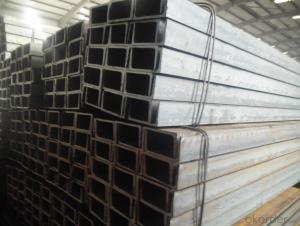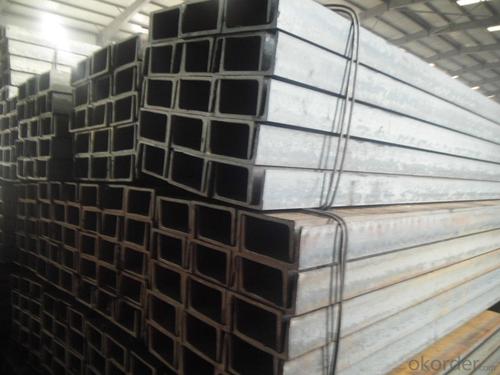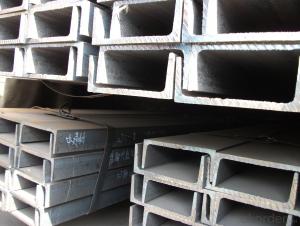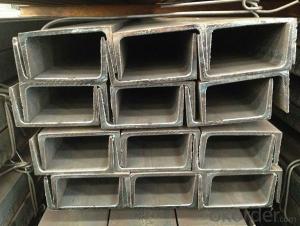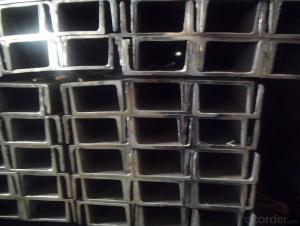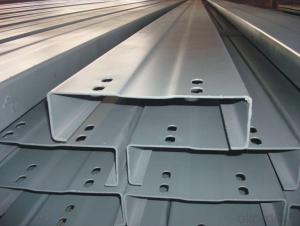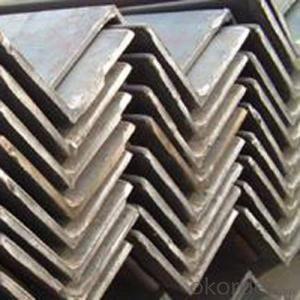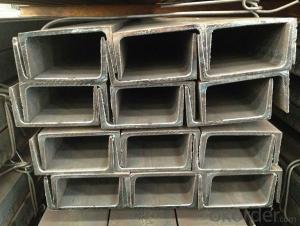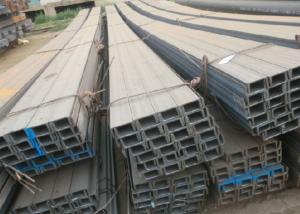JIS Standard Hot Rolled Steel U Channels for Constrction
- Loading Port:
- Tianjin
- Payment Terms:
- TT OR LC
- Min Order Qty:
- 25 m.t.
- Supply Capability:
- 200000 m.t./month
OKorder Service Pledge
OKorder Financial Service
You Might Also Like
Specifications of JIS Standard Hot Rolled Steel U Channels for Constrction:
1. We are definitely speciallizing in manufacturing and supplying channel steel as per japanese standard, which is characterised with high mechanical strength and competitive prices.
2. The sections in details are as followings in the table-1
JIS CHANNEL | Standard h | Sectional b | Dimension s | t | Mass: Kg/m |
(mm) | (mm) | (mm) | (mm) | ||
50x25 | 50 | 25 | 3.0 | 6.00 | 2.37 |
75X40 | 75 | 40 | 3.8 | 7.00 | 5.30 |
75X40 | 75 | 40 | 4.0 | 7.00 | 5.60 |
75X40 | 75 | 40 | 4.5 | 7.00 | 5.85 |
75X40 | 75 | 40 | 5.0 | 7.00 | 6.92 |
100X50 | 100 | 50 | 3.8 | 6.00 | 7.30 |
100X50 | 100 | 50 | 4.2 | 6.00 | 8.03 |
100X50 | 100 | 50 | 4.5 | 7.50 | 8.97 |
100X50 | 100 | 50 | 5.0 | 7.50 | 9.36 |
125X65 | 125 | 65 | 5.2 | 6.80 | 11.66 |
125X65 | 125 | 65 | 5.3 | 6.80 | 12.17 |
125X65 | 125 | 65 | 5.5 | 8.00 | 12.91 |
125X65 | 125 | 65 | 6.0 | 8.00 | 13.40 |
150x75 | 150 | 75 | 5.5 | 7.30 | 14.66 |
150x75 | 150 | 75 | 5.7 | 10.00 | 16.71 |
150x75 | 150 | 75 | 6.0 | 10.00 | 17.90 |
150x75 | 150 | 75 | 6.5 | 10.00 | 18.60 |
150x75 | 150 | 75 | 6.5 | 10.00 | 24.00 |
200X80 | 200 | 80 | 7.5 | 11.00 | 24.60 |
Table-1
3. The mechanical property of JIS Channel in the table-2:
Grade | Yield Strength,N/mm² | Extension Strength N/mm² | |||
Thickness of Steel,mm | |||||
≦16 | >16-≦40 | >40-≦100 | >100 | ||
SS330 | ≧205 | ≧195 | ≧175 | ≧165 | 330-430 |
SS400 | ≧245 | ≧235 | ≧215 | ≧205 | 400-510 |
SS490 | ≧285 | ≧275 | ≧255 | ≧245 | 490-610 |
SS540 | ≧400 | ≧390 | - | - | ≧540 |
Table-2
4. The chemical composition of JIS Channel in the table-3
Grade | Element(%) | |||
C | Mn | P | S | |
SS330 | -- | -- | ≦0.050 | ≦0.050 |
SS400 | ||||
SS490 | ||||
SS540 | ≦0.30 | ≦1.60 | ≦0.040 | ≦0.040 |
Table-3
Usage of JIS Standard Hot Rolled Steel U Channels for Constrction:
1.The JIS channel can be devided into two kinds, namely common channel steel and light channel steel. The sizes of hot rolled common channel steel range from 5# to 40#. Meanwhile, the channel steel can be divided into cold forming sectional equal channel steel, cold forming sectional unequal channel steel, cold forming inner edge channel steel and outer edge channel steel.
2.The JIS channel is usually used for arch-itechtural structure, and they could be welded in order to support or hang a vari-ety of facilities. They are also usually used in combination with I beam. The channel steel with sizes under 14# is usually applied to construction engineering, as purline, while the channel steel with sizes above 16# is more likely to be used in building vehicle chassis structure and mechanical structure. Furthermore, the channel steel in sizes above 30# are target at building bridge structure, as tension bar.
3.In a word, the channel steel must possess perfect welding property, riveting property and mechanical property and so on.
Package & Delivery of JIS Channel:
1.The JIS channel will be packed in bundle with steel wire at each end of every bundle and color marking in order to help the customer to recognize his goods more easily at sight.
2. And the JIS channel could be loaded into 20ft or 40ft container, or by bulk cargo.If the weight of each bundle reaches more than 3.5 mt, the loading by break bulk cargo should be choosed.When the weight of each bundle reaches less than 3mt, the loading by container should be choosed.
3.As for the transportaion from mill to loading port, the truck will be usually used. And the maximum quantity for each truck is 40mt.
4.All in all, we could do in accordance with customer's request.
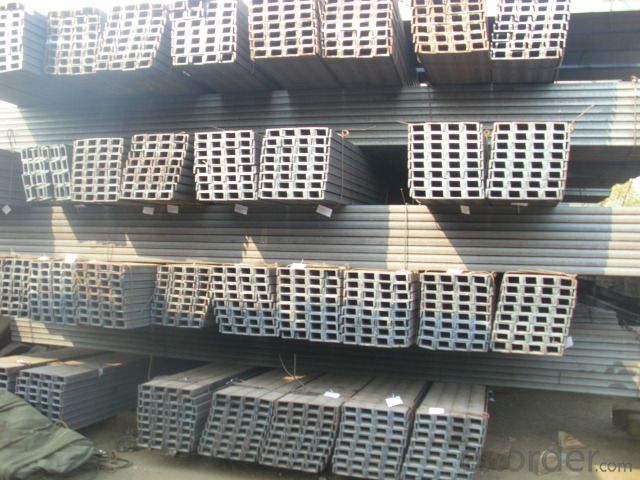
Production Flow of JIS Standard Hot Rolled Steel U Channels for Constrction:
1.The steel billet shall be heated in the high temperature furnace.
2. The heated steel billet shall be rolled five to nine times with the aim of shaping the general figure of steel u channel.
3. The rolled steel channel should be put onto the cooling bed to make the temperature low.
4. The JIS Channel should be straighted on the straightener.
5. The straighted steel u channel will be cut into meters by saw, as per customer's requirements.
6. At the last part of production, the channel steel must be tested in order to confirm that the finished products are completely free from crack, pore, slag, scab or fold on the surface.
- Q: How do steel channels compare to other structural materials?
- When comparing steel channels to other structural materials, it is evident that they have many advantages. Firstly, steel channels possess incredible strength and a high load-bearing capacity. This enables them to withstand heavy loads and provide exceptional structural support, making them suitable for a wide range of applications such as bridges, buildings, and infrastructure projects. In addition, steel channels exhibit high durability and have a long lifespan. They are resistant to corrosion, rust, and degradation, ensuring their ability to withstand harsh environmental conditions and maintain their integrity over time. This durability makes steel channels a cost-effective option as they require minimal maintenance and replacement. Moreover, steel channels offer great design versatility. They can be easily fabricated and customized to meet specific project requirements. They can be cut, drilled, and shaped into various sizes and lengths, allowing for flexibility in design and construction. This adaptability makes steel channels suitable for both simple and complex structural applications. Furthermore, steel channels possess excellent fire resistance properties. They can endure high temperatures for a longer duration compared to materials like wood or aluminum. This makes them a safer choice for buildings and structures, as they provide additional time for evacuation and minimize the risk of collapse during a fire. Lastly, steel channels are environmentally friendly. They are created from recycled materials and can be recycled at the end of their lifespan, reducing the demand for raw materials and minimizing waste. This sustainability aspect makes steel channels a preferred choice for eco-conscious construction projects. In conclusion, steel channels surpass other structural materials in terms of their strength, durability, design versatility, fire resistance, and environmental sustainability. With their numerous advantages, they prove to be a reliable and efficient choice for various construction applications.
- Q: What is the load-carrying capacity of steel channels?
- The load-carrying capacity of steel channels depends on various factors such as the dimensions and material properties of the channel, the type and distribution of the load, and the support conditions. Steel channels are typically designed to withstand both bending and axial loads. The load-carrying capacity of a steel channel can be determined using engineering calculations and standards such as the American Institute of Steel Construction (AISC) Manual. These calculations consider the section properties of the channel, including its moment of inertia and section modulus, which indicate its resistance to bending and deformation under load. The load-carrying capacity can also be influenced by the material strength of the steel channel. The yield strength and ultimate tensile strength of the steel determine its ability to resist deformation and failure under load. Higher strength steel channels can typically carry larger loads. Additionally, the support conditions of the steel channel play a crucial role in its load-carrying capacity. Channels with fixed or pinned supports will have different load-carrying capacities compared to those with simply supported or cantilevered ends. To determine the specific load-carrying capacity of a steel channel, it is recommended to consult engineering references, design codes, or consult with a structural engineer or steel manufacturer.
- Q: How do steel channels contribute to the overall safety of a structure during earthquakes?
- Steel channels play a crucial role in enhancing the overall safety of structures during earthquakes. One of the main reasons is their ability to provide structural stability and strength. Steel channels are typically used as components of the structural system to distribute and transfer loads. During an earthquake, these channels act as load-bearing members, effectively absorbing and dispersing the seismic forces to prevent localized damage. The shape and form of steel channels allow them to resist lateral forces and provide resistance against bending and twisting motions caused by seismic waves. By distributing the forces evenly throughout the structure, steel channels help in preventing concentrated stress points that could potentially lead to structural failure. Additionally, steel channels are highly durable and resistant to damage, making them ideal for earthquake-prone regions. Their high strength-to-weight ratio allows for the construction of lighter yet robust structures. This reduces the overall mass of the building, which in turn reduces the inertia forces generated during an earthquake and minimizes the likelihood of structural collapse. Furthermore, steel channels can be incorporated into seismic design strategies such as moment resisting frames or braced frames. These systems provide additional rigidity and stiffness to the structure, ensuring that it can withstand the lateral forces exerted by an earthquake. The flexibility of steel channels also allows for the absorption of energy, reducing the impact on the overall structure. In summary, steel channels contribute to the overall safety of a structure during earthquakes by providing structural stability, distributing seismic forces, resisting bending and twisting motions, and reducing mass and inertia forces. Their durability, strength, and ability to absorb energy make them a vital component in earthquake-resistant design strategies.
- Q: Can steel channels be used for conveyors?
- Yes, steel channels can be used for conveyors. Steel channels are typically used in conveyor systems to provide structural support and stability. They are commonly used as the framework for the conveyor system, providing a sturdy base for the other components such as rollers, belts, and motors. Steel channels offer high strength, durability, and resistance to wear and tear, making them suitable for handling heavy loads and prolonged use. Additionally, steel channels can be easily customized and fabricated to meet specific conveyor requirements, allowing for flexibility in design and installation.
- Q: What are the factors to consider when selecting the right type of steel channel?
- To ensure the appropriate choice is made when selecting the right type of steel channel, several factors should be taken into consideration. These factors encompass: 1. Application type: Understanding the intended use of the steel channel is crucial. Different applications may necessitate different types of steel channels, including those used for structural support, framing, or decorative purposes. 2. Load capacity: Determining the expected load or weight that the steel channel will bear is of utmost importance. This information aids in selecting a channel with the appropriate strength and weight-bearing capacity. 3. Size and dimensions: The required size and dimensions of the steel channel should be considered. This entails the depth, width, and thickness, which should be chosen based on the specific project requirements, including the desired strength and stability. 4. Material grade: The material grade of the steel channel is vital as it determines the strength, durability, and corrosion resistance. Varied grades of steel, such as A36, A572, or A588, offer different levels of strength and suitability for diverse applications and environments. 5. Surface finish: The desired surface finish of the steel channel should be taken into account. This can range from a raw or mill finish, suitable for applications where appearance is not critical, to a galvanized or painted finish, which provides additional corrosion protection and enhances aesthetics. 6. Cost: The cost of the steel channel should be assessed in relation to the project budget. It is important to strike a balance between quality and cost-effectiveness, ensuring that the chosen steel channel meets the necessary requirements without exceeding the allocated budget. 7. Availability and lead time: The availability and lead time of the desired steel channel should be considered. This is particularly important for time-sensitive projects where quick delivery is crucial. By carefully considering these factors, one can make an informed decision when selecting the right type of steel channel. This ensures that it meets the specific project requirements and delivers optimal performance and durability.
- Q: How do steel channels perform in high-vibration environments?
- Steel channels are renowned for their exceptional strength and durability, rendering them suitable for a multitude of applications, including those in high-vibration environments. In such settings, steel channels perform exceptionally well owing to their inherent properties. First and foremost, the high tensile strength of steel channels allows them to withstand substantial vibration forces without distorting or fracturing. This strength plays a pivotal role in high-vibration environments, where constant movement and mechanical stress are prevalent. The robust nature of steel channels ensures their effective handling of vibrations. Moreover, steel channels possess superb damping characteristics, enabling them to absorb and dissipate energy from vibrations. This attribute aids in minimizing the impact of vibrations on the overall structure or equipment. By reducing the magnitude of vibrations, steel channels contribute to maintaining stability and averting potential damage or failures. Additionally, steel channels can be tailored and manufactured to meet specific requirements, facilitating customization based on the intensity and frequency of vibrations. This design flexibility empowers engineers to select appropriate dimensions, cross-sections, and configurations to optimize the performance of steel channels in high-vibration environments. Furthermore, steel channels exhibit high resistance to corrosion, which is particularly crucial in surroundings where moisture, chemicals, or other corrosive agents may be present. Corrosion can undermine the structural integrity of any material, but steel channels manage to retain their strength and performance even in adverse conditions and over extended periods. In conclusion, steel channels are highly suitable for high-vibration environments due to their high tensile strength, excellent damping characteristics, design flexibility, and corrosion resistance. These attributes render steel channels a dependable and efficient choice for applications in industries such as construction, infrastructure, transportation, and manufacturing, where high-vibration environments are prevalent.
- Q: Multiple and calculation methods for channel 12
- 12 channel steel is generally 10.007kg/M, GB channel 55KG above, the successful channel steel at about 58 kilograms.
- Q: How do steel channels contribute to the overall stability of a bridge?
- Steel channels, which are often used in the construction of bridges, play a crucial role in ensuring the overall stability and structural integrity of the bridge. These channels, also known as structural steel sections, provide several key contributions to the bridge's stability. First and foremost, steel channels help distribute the load and weight of the bridge evenly across its span. By acting as horizontal beams, they effectively transfer the loads from the bridge deck to the supporting piers or abutments. This load distribution helps prevent any localized stress concentration, ensuring that the bridge can withstand the forces it encounters, such as the weight of vehicles, wind, or seismic events. Furthermore, steel channels also contribute to the torsional stability of the bridge. Torsional forces can occur due to various factors, including uneven loading, wind gusts, or the bridge's own weight distribution. By incorporating steel channels strategically in the bridge's design, these sections resist torsional forces, preventing any twisting or warping of the structure. This ensures that the bridge remains stable and maintains its intended shape over time. Additionally, steel channels enhance the overall stiffness and rigidity of the bridge. By connecting various structural elements, such as beams and columns, they provide an effective bracing system. This bracing prevents excessive deflection or bending of the bridge under loads, reducing any potential for deformation or failure. The added stiffness and rigidity provided by steel channels also help minimize the bridge's vibrations, ensuring a smoother and more comfortable experience for users. Moreover, steel channels offer versatility in their design and installation. They can be fabricated into various shapes and sizes, allowing engineers to tailor the bridge's structural components to the specific requirements of the project. This adaptability facilitates the optimization of the bridge's stability, enabling it to withstand different loads and environmental conditions. In conclusion, steel channels play a significant role in contributing to the overall stability of a bridge. They provide load distribution, torsional stability, stiffness, and rigidity, ensuring that the bridge can safely support the intended traffic loads and withstand external forces. Their versatility also allows engineers to create efficient and optimized bridge designs, enhancing the overall structural integrity and longevity of these essential infrastructural elements.
- Q: Can steel channels be used for signpost installations?
- Indeed, signpost installations can make use of steel channels. In construction and engineering ventures, steel channels are frequently employed owing to their robustness, endurance, and adaptability. They furnish a robust support framework for diverse applications, including signpost installations. Steel channels possess the ability to endure environmental elements like wind, rain, and fluctuations in temperature, thereby rendering them suitable for outdoor utilization. Furthermore, their inflexibility guarantees the signpost's stability and security. Overall, steel channels represent an outstanding option for signpost installations, proffering enduring support and dependability.
- Q: How do steel channels contribute to earthquake resistance?
- Steel channels contribute to earthquake resistance in several ways. First, they provide structural support and reinforcement to buildings and structures. Steel channels are often used in the construction of frames, beams, and columns, which are critical load-bearing components. These channels help distribute the forces generated during an earthquake evenly, minimizing the risk of structural failure. Additionally, steel channels have high tensile strength, which means they can withstand large amounts of stress and deformation without breaking. During an earthquake, buildings and structures experience lateral forces and vibrations. Steel channels, due to their strength, can absorb and dissipate these forces, preventing excessive movement and damage. Moreover, steel channels can be used to create robust connections between different structural elements. This is crucial for earthquake resistance as it helps maintain the integrity of the overall structure. By using steel channels to connect beams, columns, and other components, engineers can ensure that the structure remains stable and can withstand the dynamic forces induced by an earthquake. Furthermore, steel channels are highly ductile, meaning they can bend and deform without fracturing. This property is crucial during seismic events as it allows the steel channels to absorb and dissipate energy, reducing the impact on the surrounding structure. By absorbing and redistributing the seismic forces, steel channels help prevent concentrated stresses that could lead to failure. Overall, steel channels contribute to earthquake resistance by providing structural support, distributing forces evenly, absorbing and dissipating energy, and creating robust connections. Their high strength, ductility, and ability to withstand large amounts of stress make them a vital component in earthquake-resistant construction.
Send your message to us
JIS Standard Hot Rolled Steel U Channels for Constrction
- Loading Port:
- Tianjin
- Payment Terms:
- TT OR LC
- Min Order Qty:
- 25 m.t.
- Supply Capability:
- 200000 m.t./month
OKorder Service Pledge
OKorder Financial Service
Similar products
Hot products
Hot Searches
Related keywords
